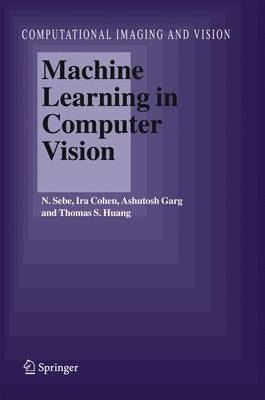
Machine Learning in Computer Vision
Springer-Verlag New York Inc.
978-1-4020-3274-5 (ISBN)
- Titel ist leider vergriffen;
keine Neuauflage - Artikel merken
It started withimageprocessing inthesixties. Back then, it took ages to digitize a Landsat image and then process it with a mainframe computer. P- cessing was inspired on theachievements of signal processing and was still very much oriented towards programming. In the seventies, image analysis spun off combining image measurement with statistical pattern recognition. Slowly, computational methods detached themselves from the sensor and the goal to become more generally applicable. In theeighties, model-drivencomputervision originated when arti?cial- telligence and geometric modelling came together with image analysis com- nents. The emphasis was on precise analysiswithlittleorno interaction, still very much an art evaluated by visual appeal. The main bottleneck was in the amount of data using an average of 5 to 50 pictures to illustrate the point. At the beginning of the nineties, vision became available to many with the advent of suf?ciently fast PCs. The Internet revealed the interest of the g- eral public im images, eventually introducingcontent-basedimageretrieval.
Combining independent (informal) archives, as the web is, urges for inter- tive evaluation of approximate results andhence weak algorithms and their combination in weak classi?ers.
Foreword. Preface 1. INTRODUCTION. 1 Research Issues on Learning in Computer Vision. 2 Overview of the Book. 3 Contributions. 2. THEORY: PROBABILISTIC CLASSIFIERS. 1 Introduction. 2 Preliminaries and Notations. 3 Bayes Optimal Error and Entropy. 4 Analysis of Classification Error of Estimated (Mismatched)Distribution. 5 Density of Distributions. 6 Complex Probabilistic Models and Small Sample Effects. 7 Summary. 3. THEORY: GENERALIZATION BOUNDS. 1 Introduction. 2 Preliminaries. 3 A Margin Distribution Based Bound. 4 Analysis. 5 Summary. 4. THEORY: SEMI-SUPERVISED LEARNING. 1 Introduction.2 Properties of Classification. 3 Existing Literature. 4 Semi-supervised Learning Using Maximum Likelihood Estimation. 5 Asymptotic Properties of Maximum Likelihood Estimation with Labeled and Unlabeled Data. 6 Learning with Finite Data. 7 Concluding Remarks. 5. ALGORITHM: MAXIMUM LIKELIHOOD MINIMUM ENTROPY HMM. 1 Previous Work. 2 Mutual Information, Bayes Optimal Error, Entropy, and Conditional Probability. 3 Maximum Mutual Information HMMs. 4 Discussion. 5 Experimental Results. 6 Summary. 6. ALGORITHM: MARGIN DISTRIBUTION OPTIMIZATION. 1 Introduction. 2 A Margin Distribution Based Bound. 3 Existing Learning Algorithms. 4 The Margin Distribution Optimization (MDO) Algorithm. 5 Experimental Evaluation. 6 Conclusions. 7. ALGORITHM: LEARNING THE STRUCTURE OF BAYESIAN NETWORK CLASSIFIERS. 1 Introduction. 2 Bayesian Network Classifiers. 3 Switching between Models: Naive Bayes and TAN Classifiers. 4 Learning the Structure of Bayesian Network Classifiers: Existing Approaches. 5 Classification Driven Stochastic Structure Search. 6 Experiments. 7 Should Unlabeled Data Be Weighed Differently? 8 Active Learning. 9 Concluding Remarks. 8. APPLICATION: OFFICE ACTIVITY RECOGNITION. 1 Context-Sensitive Systems. 2 Towards Tractable and Robust Context Sensing. 3 Layered Hidden Markov Models (LHMMs). 4 Implementation of SEER. 5 Experiments. 6 Related Representations. 7Summary. 9. APPLICATION: MULTIMODAL EVENT DETECTION. 1 Fusion Models: A Review. 2 A Hierarchical Fusion Model. 3 Experimental Setup, Features, and Results. 4 Summary. 10. APPLICATION: FACIAL EXPRESSION RECOGNITION. 1 Introduction. 2 Human Emotion Research. 3 Facial Expression Recognition System. 4 Experimental Analysis. 5 Discussion. 11. APPLICATION: BAYESIAN NETWORK CLASSIFIERS FOR FACE DETECTION. 1 Introduction. 2 Related Work. 3 Applying Bayesian Network Classifiers to Face Detection. 4 Experiments. 5 Discussion. References. Index.
| Erscheint lt. Verlag | 3.6.2005 |
|---|---|
| Reihe/Serie | Computational Imaging and Vision ; Vol.29 |
| Zusatzinfo | biography |
| Verlagsort | New York, NY |
| Sprache | englisch |
| Maße | 160 x 240 mm |
| Gewicht | 549 g |
| Einbandart | gebunden |
| Themenwelt | Informatik ► Theorie / Studium ► Künstliche Intelligenz / Robotik |
| ISBN-10 | 1-4020-3274-9 / 1402032749 |
| ISBN-13 | 978-1-4020-3274-5 / 9781402032745 |
| Zustand | Neuware |
| Haben Sie eine Frage zum Produkt? |
aus dem Bereich


